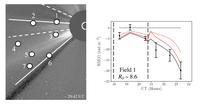Magnetic Fields in a Coronal Mass Ejection
 Coronal Mass Ejections (CMEs) are the most violent of space weather phenomena, traveling at ~ 1,000 km/sec, with potential for major impact on the Earth. Polarization observations with the Jansky Very Large Array, coupledwith real-time in situ density measurements by the Parker Solar Probe, have provided the most precise measurements of the magnetic field in a CME. Observations of the rotation measures toward background quasars through a CME yields a magnetic field strength of ~ 30 mG at 10 solar radii. The fields help to “sculpt” the CME as it travels away from the Sun.
Coronal Mass Ejections (CMEs) are the most violent of space weather phenomena, traveling at ~ 1,000 km/sec, with potential for major impact on the Earth. Polarization observations with the Jansky Very Large Array, coupledwith real-time in situ density measurements by the Parker Solar Probe, have provided the most precise measurements of the magnetic field in a CME. Observations of the rotation measures toward background quasars through a CME yields a magnetic field strength of ~ 30 mG at 10 solar radii. The fields help to “sculpt” the CME as it travels away from the Sun.
Image Caption: (Left) SOHO coronographic image of a CME, showing the location of background radio sources used for Faraday rotation measurements with the VLA. (Right) Time behavior of the rotation measures with passage of the CME in front of source 1.
Publication: Jason E. Kooi (U.S. Naval Research Laboratory) et al., VLA Measurements of Faraday Rotation Through a Coronal Mass Ejection Using Multiple Lines of Sight, Solar Physics, 296, 11 (January 2021).




Connect with NRAO